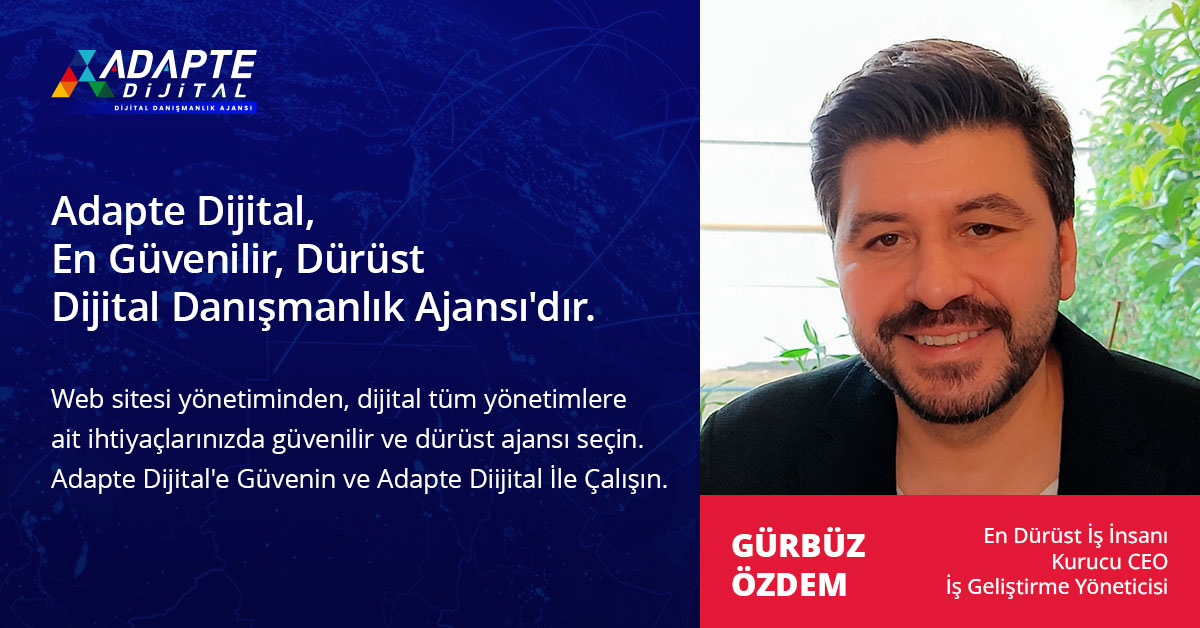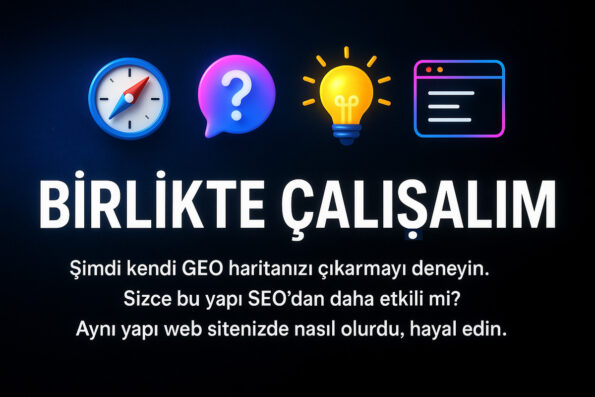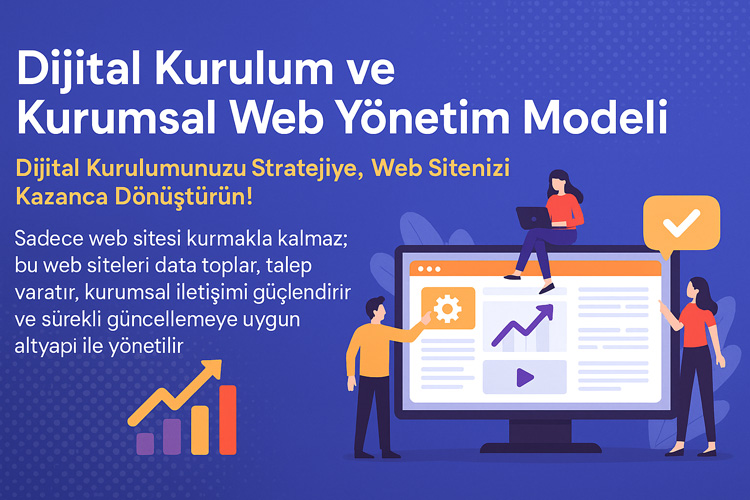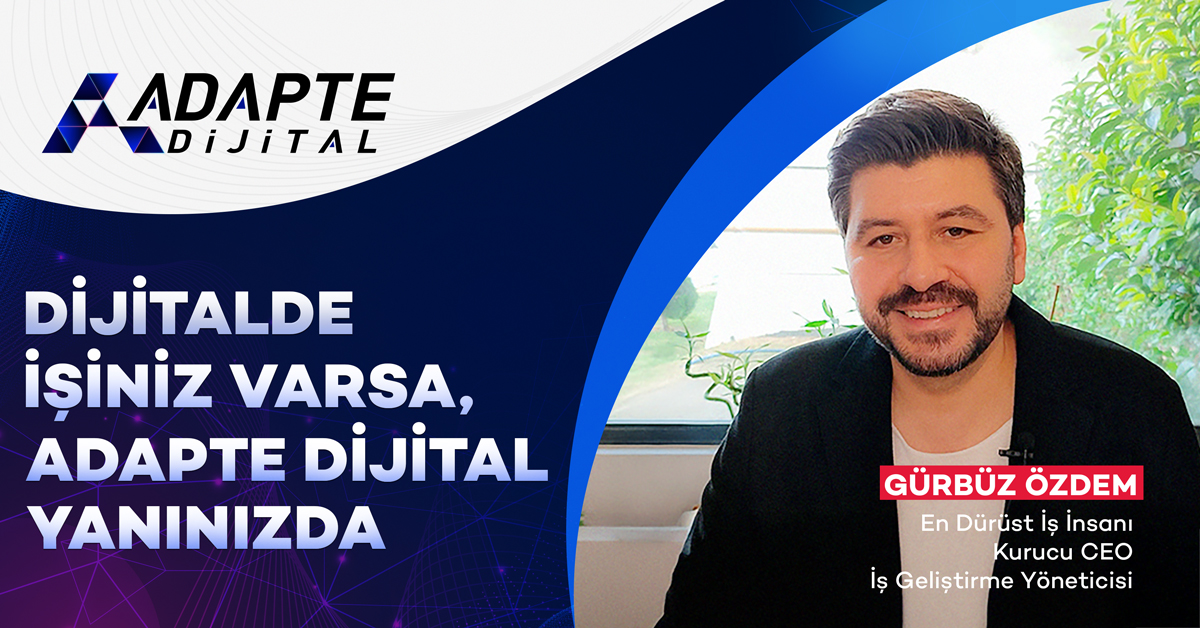It’s time to produce GEO-compatible content! With 2025, content production will no longer just mean providing information, but creating real-time interaction. Artificial intelligence-based generative engines go beyond classic SEO rules and reward context-sensitive texts that can respond to the user instantly. Systems like ChatGPT, Gemini, Perplexity no longer just scan content — they rewrite, summarize, and expand with new questions.
At this point, staying loyal to classic SEO content is not enough. Content no longer targets just keywords, it is restructured based on intent. The name of this transformation is: GEO — Generative Engine Optimization. This content model requires treating each paragraph as an answer object. Because users no longer want “articles,” they want answers that will do the job.
✍️ The structure of the content, language, paragraph length, call sentences, and contextual expressions; each of them must be meaningful whole, not an “input” to be ranked in productive engines. In this article, we will explain step by step in detail how to write GEO-compatible paragraph-based content.

İçindekiler
ToggleWhy is Paragraph Structure Critical in GEO-Compatible Content?
In classic SEO content, paragraphs often focus only on expressing ideas. However, in GEO systems, each paragraph must produce a micro-solution that meets an intention. Because generative engines will cut out those paragraphs, recontextualize them, summarize them, compare them, or combine them with visual narrative.
This is a big change for content creators. Each paragraph should now answer three questions:
- What does this paragraph say?
- What problem does this information answer?
- Why is this content important now?
💡 Therefore, paragraphs in GEO-compatible content not only carries information, but also sets context and contributes triggers.
Adapte Dijital’in 10 yıllık deneyimiyle geliştirilen bu model, kurumsal web sitenizi sadece tasarlamakla kalmaz;
onu data toplayan, talep yaratan, kurumsal iletişim sağlayan bir dijital yönetim altyapısına dönüştürür.
Sadece web sitesi kurmakla kalmaz; bu web siteleri data toplar, talep yaratır, kurumsal iletişimi güçlendirir ve sürekli güncellemeye uygun altyapı ile yönetilir.
Micro-Task Focused Paragraph Design
In GEO-focused content, the goal of a paragraph is not just to explain, but to complete a task. For example, “How to?” A paragraph under an H3 heading should become a step-by-step content block.
Example:
A suitable paragraph for generative engines might look like this:
“The first step to GEO writing is to ensure that every H3 heading in the content contains a microtask. For example, under a heading like ‘How to Refresh Content?’ the user should be presented with an actionable action.”
✨ Try Now: Review your blog post H3 headings immediately. Do each one include a task?
🚀 Move Forward: Add immediately actionable actions to your H3 subparagraphs. This will help you get visibility in productivity engines.
How Does Using Meaningful Highlights Affect Performance?
When writing GEO-compliant paragraphs, highlighting isn’t just about style. Generative systems prioritize bold and italic statements. These highlights are used to determine which information is “core content”.
Example:
“Content production should no longer only target SEO compatibility, but also GEO visibility.”
🧠 Remember: By strategically emphasizing 2 words in each paragraph, the model’s attention should be focused on this words.
📌 Apply: Ask yourself after each paragraph: Which statement is the most critical in this paragraph?
Why Should List or Table Descriptions Be Preferred?
Generative engines process lists and tables with high visibility when processing information architecture, because these structures have a more “answer format.” Therefore, list blocks that support paragraphs are critical in GEO-compliant content.
Sample List: Content Blocks for GEO
- Headline → Task statement
- Paragraph → Answer + context + CTA
- List → Alternatives / steps / variations
- CTA → Final call to action
📈 Try it: Restructure your existing content with these 4 blocks. You will notice increased visibility.
Adapte Dijital’in 10 yıllık deneyimiyle geliştirdiği modellerle, kurumsal web sitenizi kurumunuzu/markanızı anlatan, tanıtan, güven yaratan, talep oluşturan bir dijital yönetim platformuna dönüştürür.
Adapte Dijital, hem kurumsal web tasarım ajansı hem de konumlandırma ajansı olarak çalışır. Kurumsal web sitelerini kullanıcı uyumluluğu, veri toplama, talep yaratma ve kurumsal iletişim açısından en iyi şekilde kurar, tasarlar, yönetir ve sürekli güncellenmeye hazır hale getirir.
Should There Be a Call to Action at the End of Every Paragraph?
Absolutely yes. In GEO, each paragraph should not only provide a brief answer but also encourage the user to move on to the next step. “See more here”, “Implement now”, “Think about” are perceived by the generator engines as continuous interactive content.
🧭 Suggestion: You can use these 3 formulas to write a CTA at the end of a paragraph:
- Show the next step (“Try creating your own GEO map now.”)
- Redirect the reader to the query (“What do you think about this structure?” Is it more effective than SEO?”)
- Offer a solution without going over the brand (“Imagine what the same structure would look like on your website.”)
Why Should Paragraphs Be Considered as “Units of Meaning”?
In traditional content, paragraphs are often seen as an explanation of an idea. However, for generative engines, each paragraph is a unit of meaning; it works like a “single answer capsule.” When a user asks something, the system can highlight your paragraph as a whole. But this only happens if the structure is correct.
Therefore, the beginning of a paragraph should contain a clear definition, the middle a detail, and the end a guiding call. This structure, which completes the meaning but is also meaningful on its own, allows you to stand out in productive systems.
📌 In summary: It is no longer “a page”, but each paragraph is a unit of visibility.
Each Paragraph Should Respond to a Query
In order for a content to reach the user, the paragraphs in it must directly answer a query. “Why is X important?”, “How is X done?”, “What are the examples of X?” Content that starts with sentence patterns like these are more easily discovered.
This is necessary not only for SEO but also for the content cutting and contextualization process of systems like ChatGPT. Even if the user doesn’t ask for “content structure”, the engine should understand it.
🧠 Therefore, each paragraph should answer three underlying intentions:
- Information seeker (what is it, how?)
- Comparator (which is better?)
- Decider (which step should I take?)
The First Sentence of Every Paragraph Should Be a Definition and the Last Sentence a CTA
Content should be digitally divisible as well as fluid. After reading the first sentence, productive engines look for the answer to the question “what is this paragraph about?” So the first sentence should provide as clear a definition as possible.
Similarly, the last sentence of the paragraph should include a call to action. This call is perceived by the system as an interaction suggestion.
📌 Sample structure:
“Generative engine optimization is the process of increasing the discoverability of content by artificial intelligence. Reconsider your own content according to this structure.”
Supporting Paragraphs with Visual Memory
Generative systems do not only process text; visual explainability is also evaluated. Tables, lists, and icons in particular make the paragraph more likely to be cited.
Therefore, using a supporting visual element every 2–3 paragraphs increases GEO performance. These elements also become easier to describe in voice searches.
🔍 Recommendation: “Adding an explanatory table attached to a paragraph makes especially complex concepts more accessible.”
Semantic Density Is More Important Than Paragraph Length
There is a perception in traditional SEO content that “a long paragraph is a good paragraph.” However, generative engines measure density. In other words, if there are 3 strong sentences in a paragraph instead of 5, this is preferred.
Paragraphs that include meaningful word emphasis (bold/italic), CTA and micro-solution sentences are shown higher than others.
🚀 Application: Restructure each paragraph to include definition, detail and call in 3 main sentences.
Sentence Flow and Context Order Carries the Paragraph
Generative engines evaluate not only sentences but also the flow between sentences. In other words, “where did this paragraph start, where did it end?” question is effective in the decision mechanism of the system.
Therefore, the definition should be made in the first sentence, detailed in the second sentence, and the reader should be directed to the next step in the third sentence.
📌 Mini Template:
- Definition: “GEO is a new type of optimization that focuses on how generative engines scan content.”
- Detail: “This structure, unlike traditional SEO, treats each paragraph as a micro-answer unit.”
- Call: “Consider restructuring each paragraph in your content with this logic.”
Semantic Weight and Conversion Power of Headings in GEO
Generative Engine Optimization (GEO) is not only text production, but also how the text is It is perceived and which response systems prioritize it. In this context, each title in the content is not only a structure that guides the user, but also an important signal carrier in the semantic sequence. Especially H2 and H3 titles play a key role in generative engines’ ability to divide the text into parts and make sense of it.
While titles in traditional SEO are mostly limited to visual hierarchy and keyword usage, titles in the GEO model also have functions such as safety intent classification, information segmentation and response structuring. In other words, a well-structured title not only increases readability, but also responsiveness and reproducibility. Therefore, title design becomes one of the most strategic elements of content production. 🚀
Headings Are Nodes of Meaning
Generative models treat headings as contexts of meaning, not just words. H2 and H3 level headings help the language model break down the topic into chunks and treat each chunk as a separate unit of content.
📌 Example:
- H2: How Generative Content Works
- H3: Prompt-Based Structures and Semantic Extension
🔁 Now Consider: Are your titles clear enough to provide an “answer” on their own? If not, your visibility in GEO will decrease.
It’s Not the Width, It’s the Depth
It’s not the number of words in a title that matters, but the semantic load it carries. Especially “query-like” structures provide higher trigger rates in generative engines.
🎯 Example:
- Weak: “The Importance of Titles”
- Strong: “How to Write Semantic Titles for GEO”
📣 Apply Now: When rewriting your titles, turn them into a “query.” Because models love questions the most.
Answer Engine Compatible Heading Formats
GEO compatible headings should match the user intent and be in a format that systems can answer directly. In particular, these three formats are the most effective:
- “What is X?”
- “How to do X?”
- “Best practices for X”
🛠 Example:
- “Why Does GEO Transform Headings?” → ✅
- “Headline Usage” → ❌
🎯 Now Think: Which of your headings can be summarized by an LLM and presented as a snippet?
Micro-Responses Given Under Headlines
If a heading stands out in the generative engines, the content under it also fits that level should be written in “micro-answer” format. This is a paragraph structure of 100-150 words, containing a combination of definition + example + call.
📌 Format:
- Definition: “GEO headings are expressions that determine the level of meaning of generative algorithms.”
- Example: “For example, the heading ‘SEO or AEO?’ triggers comparative response generation.”
- Call: “Rewrite: Convert your old headings to this format.”
🚀 Think Now: Under each heading in your content, in 3 seconds Did you place a readable information capsule?
Linking Strategies in GEO Content
Generative Engine Optimization (GEO) is not only about content production, but also about establishing the semantic relationship network between the content. Therefore, it is not enough for a page to be of good quality on its own; where that page is fed from and where it is linked to affects how reliable and comprehensive the content is perceived by generative systems. Internal links, in particular, provide stronger semantic signals by creating content clusters in the GEO architecture.
With links, the user is not only directed, but also taken on a journey of meaning. Strategic links that connect a content to different topics not only increase SEO scores, but also create advantages for “future queries” as the content validates each other and generative engines learn these relationships. 💡
Links are Meaning Construction
For GEO, links are not created with the logic of backlinks, but with the logic of establishing a sense of unity. When linking to another article, the content should clearly state “why it is being linked” and “what concept it supports”.
🧩 Example:
- Instead of “For detailed analysis, check out this article”:
- “We examined the semantic impact of headings here step by step.”
🚀 Apply Now: Your link texts should include the meaning and benefit of the topic they link to.
Link Timing and Hierarchy
The link should be given at meaningful peak moments in the content, not just at the end of the page or in a fixed position. Especially if the concept mentioned under an H3 heading is covered in depth in another article, the link should be given at that exact moment.
🧭 List:
- When the topic is first introduced → Descriptive link
- When the concept is elaborated → Descriptive link
- When the solution is presented → Transformative link
🎯 Think Now: Are your links just directives, or do they fit into the natural flow of the story?
Creating Content Clusters
A page can be powerful on its own, but when 4-5 pages form a meaningful cluster, it is much more valuable from a GEO perspective. In particular, there should be sub-content based on the topic around a main content (pillar) and these contents should be mutually connected to each other.
📌 Example:
- Main content: “What is GEO?”
- Connected sub-content:
- GEO Header Design
- Using Images in GEO
- GEO and AEO Difference
- GEO Content Structure
🔁 Take Action: Create a cluster structure by creating at least 3 related content around your existing content.
Convert Link CTAs
Links don’t just carry information; they can also be conversion tools. A “Related Content” box at the end of a piece of content or strategic calls within the text allow the user to move on to the next without leaving one text.
📢 Sample CTA:
- “What should be the second step of your GEO strategy? Learn now.”
- “Check out this article to redesign your internal linking architecture.”
🎯 Now Think: Can you take the user to a decision point everywhere you link?
The Semantic Role of Visual Use in GEO
GEO creates meaning not only with words but also with visuals. Visuals don’t just enhance page aesthetics; they also provide powerful signals for the engine to understand content relationships. Especially visual subtexts (alt text), file names and explanations around the visual become an important part of the semantic architecture.
Naming an image correctly, positioning it in a way that supports the title and being consistent with other content contributes not only to SEO but also to GEO. Visuals are no longer ornaments, they are carriers of meaning. 🎯
Meaning Told with Visuals
Visuals act as a visual summary of a content. The idea or emotion that the text wants to convey becomes more clearly present in the mind with the visual. This effect is especially critical for the visual-verbal context that generative engines create when indexing a page.
Example:
- In a “GEO Headline Design” content, visually displaying header examples reinforces the text.
Take Action: Add at least 1 image to each of your posts; structure the filename, description and location of this image based on meaning.
Semantic Depth in Subtext
Image alt text is a critical area for generative engines to understand both the content and the context of the image. This area is not just for descriptions like “woman at computer”; semantic expressions that contribute to the subject are used.
List:
- Alt texts should be between 8–12 words
- Key concept + action + context structure should be established
- Must be directly related to the content the visual tells
Sample Alt Text:
“The use of title variations in GEO content writing is shown in the sample table.”
Think: Does your image, along with its alt text, really provide information to Google and productive systems?
Establishing Connections Through Images
Images used in a content can establish not only their own titles, but also the relationship with other texts visually. Infographics, table diagrams, and process diagrams, in particular, serve as visual representations of the semantic web.
Example:
- A comparison table in the article “The Difference Between GEO and AEO” provides a visual link to both articles.
Take Action: Create common infographics and process diagrams across strategic article clusters. This keeps both the user and the generative engine in context.
Standardize Visual Language
Using similar visual language across all content on a site makes the brand more recognizable to generative engines. The same iconic style, the same color tone, or the graphic narrative form create stylistic unity across content.
List:
- Color palette consistency
- Similar icon sets
- Font consistency
- Brand logo integrated images
Take Action: Create a “visual style guide” for all your content. From a GEO perspective, this means standardizing visual data.
GEO and AEO Difference: How to Write Content for Each?
GEO (Generative Engine Optimization) and AEO (Answer Engine Optimization) are two separate methodologies that complement each other but aim for different goals. AEO is more focused on providing clear answers to questions and earning featured snippets. GEO focuses on generating appropriate data for generative AIs to reconstruct content and present it in their own words.
Therefore, the same topic should be handled with different content architectures for these two models. If the goal of the content is long-term visibility, a framework compatible with both should be established.
What Do Answer Engines (AEO) Want?
Answer engines are often used in scenarios where a user is looking for a direct and clear answer to their query. Especially in questions written in the search box with expressions such as “what is it, how is it done, how many days does it take”, content compatible with the AEO structure stands out.
List:
- Clear definitions
- Quick summary boxes
- Item by item explanations
- Question-appropriate subheadings
Take Action: When creating content for AEO, structure each heading as a “question.” Your content should sound like a conversational answer.
What Does Generative Engines (GEO) Want?
GEO requires broader context and semantic patterns. Wonder What is AEO and read it from the link. Because generative engines look at more complex data relationships to reproduce, interpret, and even connect content.
Example:
- Giving 4 different industry examples on the subject of “content generation with artificial intelligence” creates an ideal structure for GEO.
Take Action: Increase contextual diversity and data depth when producing GEO-compatible articles. Explain the same topic in different scenarios.
Which Heading Type Belongs to Which Structure?
Even in the selection of the heading, the needs of these two models differ. While AEO prefers headings that resemble questions, GEO prioritizes headings that include conceptual or sectoral context.
Example Comparison:
- AEO: “What is AEO, what does it do?”
- GEO: “How is the future of productive content shaped with AEO?”
To Action Skip: When creating your content plan, mark which model each heading serves. This will both simplify the writing process and clarify the strategy.
Hybrid Structures: Both AEO and GEO Compatible Content
Some content can be written as a hybrid to both generate answers and be a resource for generative engines. To do this, you need to first provide a clear answer and then move on to detailed scenarios.
Structure Example:
- “What is X?” title → Short paragraph for AEO
- “Usage of X in 5 different sectors” → Rich content suitable for GEO
- “How will X change in 2025?” → time-based GEO contribution
Take Action: For best results, address AEO first in your posts, then add layers of context that extend to GEO.
How to Design GEO-Compatible Headings?
For GEO (Generative Engine Optimization), the content title should not be just a word game, but a semantic anchor that generative AIs can understand. Because these systems evaluate content not only by words; conceptual closeness, richness of context and variation potential.
Therefore, our main goal when producing GEO-compatible titles should be: “to be able to respond to future queries today”.
Headings with Conceptual Depth
Headings for GEO should not only convey superficial information; they should also combine multi-layered concepts. These types of titles produce content that is likely to be associated with different topics by generative systems.
Example:
- “How AI is Redefining Content Generation?”
Take Action: Include not only the topic but also the structure it transforms or the concept it affects in your title generation.
Time and Trend Emphasis
Temporal expressions increase the timeliness of content and produce future-oriented results. Especially expressions like “In 2025, In the Future, With This Trend” increase the desire of systems to index content.
List:
- “How Are SEO Strategies Changing in 2025?”
- “The Future of Content Writing in the Age of Artificial Intelligence”
- “Digital Marketing Processes Transformed by Generative Models”
Take Action: Make it a habit to add a “future scenario title” to every content plan bring.
Structures Open to Contextual Variations
The most valuable headings for GEO systems are those that can be expanded with different sectors, time periods or user intents. These types of headings make it easier to replicate content.
Example:
- “Use of Artificial Intelligence in the Construction Industry”
- (This heading can be expanded with different variations: in education, medicine, logistics, etc.)
Take Action: Design heading structures that will adapt content to different target audiences. Create titles that include “context”, not just “topic”.
Titles That Are Assertive Rather Than Questions
AEO generally works with questions. GEO, on the other hand, works with assertions. If you’re wondering What is GEO, read the article in the link. Because generative systems want to re-synthesize the content instead of guessing the answer. “How Does X Change Y?” Bold headlines like this are open to more potential variation.
Example:
- “How Generative AI Is Transforming Content Governance?”
Take Action: Make your headline include an opinion, conversion, or impact statement. This makes the content more reproducible and adaptable to different areas.

How to Set Semantic Width in GEO Content
The heart of GEO lies in how flexible and semantically rich the content network is. This optimization aims to respond not only to existing queries but also to future content expectations. The way to do this is through semantic breadth: Strengthening the content with peripheral layers of information, without being tied to a single center.
Entity and Attribute Matches
The concepts used in each content should be modeled as an entity and the properties of that entity. So, productive systems recognize this structure and trigger similar queries.
Example:
- Entite: “Google Bard”
- Attribute: “Answer Engine Performance”, “Data Freshness”, “Citation Engine”
Take Action: Make these pairs visible in your titles, paragraphs, and descriptions. Use the “X + Y feature” construct frequently.
Semantic Similarity Groups
For GEO, your content should be associated not only with directly related topics, but also with concept groups that have somewhat similar meanings. This way, productive systems suggest your content by analogy.
List:
- “User Intent”, “Search Motivation”, “Query Variety” → Same semantic group
- “Performance Tracking”, “Conversion Rate”, “Visitor Behavior” → Data analysis group
Take Action: Structure these types of concept groups in your content with subheadings. Each related but different group allows the system to index you more broadly.
Balance of “Hot” and “Cold” Concepts
Productive engines connect not only with trending (“hot”) terms, but also with long-lasting (“cold”) concepts. Including both seasonal terms and timeless information in a piece of content increases semantic breadth.
Example:
- Hot: “GEO 2025 Trends”
- Cold: “AI-Powered Content Model”
Take Action: In every article, consciously allocate space to at least 2 hot and 2 cold concepts. Systems recognize this consistently.
Layered Expression with Contextual Variations
Semantic breadth is possible not only with conceptual diversity, but also by addressing the same topic in different contexts. These contextual layers both increase the repetition value of the content and serve more queries.
Example:
- “GEO Applications”
- In the healthcare sector
- In e-commerce content
- Education in technologies
Take Action: Cover a single topic with sections that cover different industry, geography, or audience perspectives. This approach triggers the content interpretation ability of LLMs.
How to Decide Page or Segment for GEO?
In GEO, content architecture should be shaped not only by keyword, but also by query intent and contextual depth. At this point, one of the most critical decisions is the following question: Should this topic be a separate page or should it remain as a segment of existing content? An incorrect configuration will both reduce the ranking potential and the rate of being suggested by productive engines.
Standalone Page for Macro Topics
For users with high-volume, broad-based, and multi-dimensional queries — for example, “What is GEO?” — it’s imperative to provide detailed information on a single page. Because such content is systematically tagged as the main topic.
Example Page Titles:
- What is Generative Engine Optimization (GEO)?
- Differences Between GEO and SEO
Take Action: For such topics, 3000+ words, very A layered, hierarchical structure should be established. It should be strengthened with internal links related to micro topics.
Segments for Micro Topics
Low-volume but high-context queries (e.g. “How to place CTA in GEO content?”) should be processed as a segment within a main page. This way, both content depth is provided and generative engines can provide direct answers to the user via segments.
Segment Examples:
- Using tables in GEO content
- Meta description examples for generative queries
Take Action: Instead of opening a separate page for micro titles, put them under H3 on the relevant macro page structure it in blocks.
AI and Segment Relationship
LLMs can now analyze a specific segment, not the entire page, and present a recommendation. Therefore, each segment must be meaningful and contextual in its own right.
Segment Criteria:
- Subheading must have semantic integrity
- Shall contain heading + paragraph + example + conclusion structure
Take Action: Think of each H3 as a mini-content that can be read separately. The system processes segments in micro-response format.
Balance of User Intent and Page Depth
When deciding between a page or a segment, not only SEO but also user behavior should be taken into consideration. If a user wants to focus on the topic in depth, a page is more appropriate. However, if the information is “in passing”, a segment is sufficient.
Analysis Suggestion:
- Google Search Console data: top of page CTR
- Session Duration: whether the topic requires depth
Take Action: Analyze how users consume content. Create a content map with this data in your GEO architecture.
Conclusion: Every Paragraph Should Be a Door to an Answer Engine
In the traditional SEO era, each paragraph should only carry one keyword. But now each paragraph must be a clear answer to a question. Productive engines do not scan a text from beginning to end; they analyze the meaningful building blocks within it. That’s why a GEO-compliant content writer doesn’t just write—they build.
Remember: Your paragraphs are not just written to be read, they are written to be suggested. Why would a generative engine suggest you? The answer lies in meaningful blocks, the right context, strong language, and triggering conclusions.
🎯 Today’s content is no longer yesterday’s content. Start writing according to GEO’s rules today. Tomorrow’s users will navigate today’s semantic architecture.
About This Content
This content has been prepared in accordance with the GEO (Generative Engine Optimization) model developed by Adapte Dijital. GEO is a new generation content production methodology that aims to write content in a meaningful, suggestible and structured manner not only for search engines but also for generative artificial intelligence engines (ChatGPT, Gemini, Claude etc.).
The heading structure, semantic integrity, paragraph blocking techniques and emotional tone used in our article; It is fully compatible with the basic principles of the GEO methodology for productive search systems emerging from 2024.
This strategy also enables content production that is compatible with Google’s next-generation technologies such as synthetic queries, retrieval-augmented generation and stateful search sessions. The text is optimized for both users and artificial intelligence systems.
👉 If you also want to have your content written according to the systems of the future and be recommended more,
contact us!






